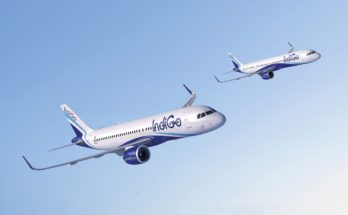
Boeing and Embraer continue to move forward with their commercial aircraft tie-up with the merger slated to close in late 2019.
Under the multi-level deal, the new Boeing Brasil – Commercial (BBC) joint venture will be majority owned by Boeing. A second venture, majority owned by Embraer, will focus on promoting and developing the KC-390 airlifter. Finally, Embraer will continue to hold onto its business jet operations, which are currently focused on producing the Legacy and Praetor families of executive aircraft.
The formation of BBC was in direct response to the formation of rival joint venture, majority led by Airbus, to take over the Bombardier CSeries program. This effort, begun in late 2017, became official in July 2018 when Airbus assumed a 50.01 percent controlling stake in the program. The CSeries was quickly rebranded as the Airbus A220 after taking control of the program.
Boeing, through BBC, will use its marketing and support operations to push the E-Jets family against the rebranded Airbus A220 lineup. There is very little competitive overlap between Boeing and Embraer’s two product lines, consisting only of some indirect competition between the E195-E2 and the 737 MAX 7. More important, the tie-up will enable a comprehensive and broad-based attack on the Airbus A220 series, with the E190-E2 and E195-E2 challenging the A220-100 version, and the 737 MAX 7 and 737 MAX 8 battling the A220-300.
Once BBC is operational, Embraer will focus on business jets, MRO and its KC-390 military airlifter. In the bizjet market, Embraer continues to face some headwinds. Low aircraft prices in the pre-owned market along with cheap oil could pose difficulties in the company’s efforts to increase sales.
After stalling in 2015, the business jet market shifted into reverse in the years that followed. Reduced oil revenues and serious economic slowdowns in emerging markets in Asia, Latin America, and Russia adversely affected demand for such aircraft. As a result, Embraer posted sales of $5.07 billion in 2018, down 13 percent from the $5.84 billion reported in 2017. The company posted a loss of $178 million compared to net income of $263 million for 2018. The loss in 2018 was due to fewer commercial and executive aircraft deliveries.
Now, due to continuing improvement in global economic conditions, moderately increasing oil prices, and a return in force of U.S. buyers to this portion of the market, demand is expected to rise in 2019 and 2020. However, according to Forecast International’s Civil Aircraft Forecast, a minor two-year downturn in the 2021-2022 timeframe is anticipated, with growth in yearly production resuming by 2027. Over this period, Embraer is expected to rank second in terms of production, behind Cessna and ahead of Bombardier.
Thanks to earlier development efforts, Embraer is well diversified in this market, holding a presence in seven of the eight business jet market segments as defined by Forecast International. The company’s business jet line now covers each market segment – from the very light jet (VLJ) class through the large-cabin category, and includes a product in the corporate-configured airliner class. This positioning is helpful in the current business climate, as a strong showing in one sector can help offset lower results in another.
One area that Embraer is looking to expand is its maintenance, repair and overhaul sector. The company organized a new services division in 2017 that consolidates the service capabilities that had been spread throughout its different business units. The new Global Services and Support sector is now the focus of all of Embraer’s commercial, executive, and defense-related MRO offerings. With aftermarket support being a key revenue generator, the new operation should be able to grow, thanks to an expanded portfolio and reduced operational redundancies. With 2,000 Embraer aircraft in service around the world, the company is aiming to capture a larger share of the services aftermarket than it has in the past.
In its third market, defense and security, Embraer completed its final milestones in 2018 with the initial production KC-390 making its first flight in early October. Later that month, the KC-390 was awarded final type certification by the Agência Nacional de Aviação Civil (ANAC), the Brazilian civil aviation authority. Currently, Embraer also has letters of intent (LOI) for 38 KC-390s, and is in the process of converting these to firm orders. At least initially, Embraer intends to build about 10 KC-390s per year.
The Brazilian government has estimated that up to 300 KC-390s could be sold on the export market over a period of 20 years. In the years ahead, potential customers for the aircraft will be found among operators that are looking to replace aging C-130s, a large number of which remain in service worldwide. Sales may also be boosted by the upcoming establishment of a joint venture with Boeing that is intended to promote and develop new markets for the airlifter.
In 2015, Saab and Embraer signed an agreement that established a partnership for joint management of the F X2 project for the Brazilian Air Force. The agreement concluded more than a year of negotiations following Brazil’s selection of the Gripen NG fighter for the contract in December 2013. Under the manufacturing plan for the Gripen NG – named the F-39 in Brazil – Embraer will receive a significant technology transfer package from Saab. The company will also be actively involved in finalizing the single-seat F-39 aircraft’s design and will develop with Saab the two-seat F-39 variant in Brazil. A production line has been established at Embraer’s Gavião Peixoto industrial facility. Deliveries of the 36 Brazilian Air Force Gripen NGs are scheduled to begin in 2019 and be completed in 2024. Approximately 10-15 of the aircraft are to be assembled in Brazil by Embraer.
Finally, Embraer has been actively expanding its global footprint with facilities in key countries around the world. Currently, its global footprint includes its home in Brazil as well as operations in the U.S., Mexico, and Portugal. These facilities include not only pilot training and service centers but also business jet manufacturing operations. For example, in the U.S. (Melbourne, Florida), the company assembles Phenom 100 and 300 aircraft (and recently added the Legacy 450 and 500), while in Portugal, the Évora facility manufactures wings. Such geographic dispersion helps protect the company from single-currency fluctuations. Perhaps more important, this diversity changes the mindset that Embraer is simply “a Brazilian company,” and reinforces its position as an international aerospace firm.
A military history enthusiast, Richard began at Forecast International as editor of the World Weapons Weekly newsletter. As the Internet grew in importance as a research tool, he helped design the company's Forecast Intelligence Center and currently coordinates the EMarket Alert newsletters for clients. Richard also manages social media efforts, including two new blogs: Defense & Security Monitor, covering defense systems and international issues, and Flight Plan, which focuses on commercial aviation and space systems. For over 30 years, Richard has authored the Defense & Aerospace Companies, Volume I (North America) and Volume II (International) services. The two books provide detailed data on major aerospace and defense contractors. He also edits the International Contractors service, a database that tracks all the contractors involved in the programs covered in the FI library. More recently he was appointed Manager, Information Services Group (ISG), a new unit that encompasses developing outbound content for both Forecast International and Military Periscope.


